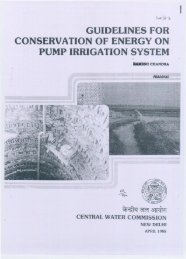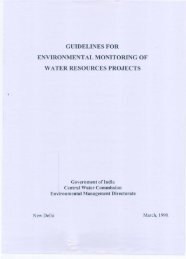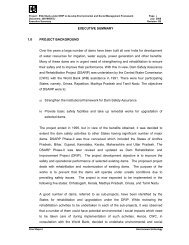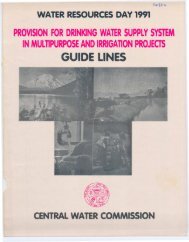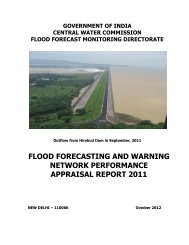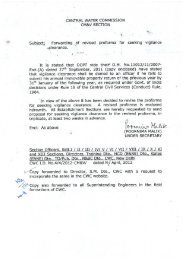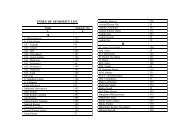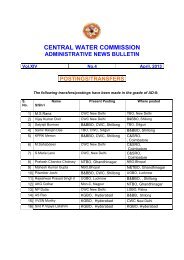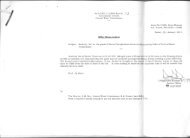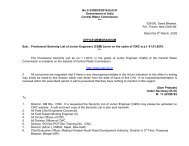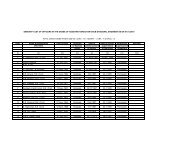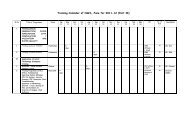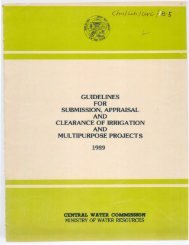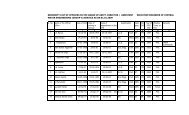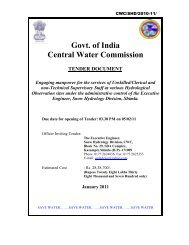How to measure Ammonia and Organic Nitrogen: Kjeldahl Method
How to measure Ammonia and Organic Nitrogen: Kjeldahl Method
How to measure Ammonia and Organic Nitrogen: Kjeldahl Method
Create successful ePaper yourself
Turn your PDF publications into a flip-book with our unique Google optimized e-Paper software.
World Bank & Government of The Netherl<strong>and</strong>s funded<br />
New Delhi, March 2000<br />
Training module # WQ - 38<br />
<strong>How</strong> <strong>to</strong> <strong>measure</strong> <strong>Ammonia</strong> <strong>and</strong><br />
<strong>Organic</strong> <strong>Nitrogen</strong>: <strong>Kjeldahl</strong><br />
<strong>Method</strong><br />
CSMRS Building, 4th Floor, Olof Palme Marg, Hauz Khas,<br />
New Delhi – 11 00 16 India<br />
Tel: 68 61 681 / 84 Fax: (+ 91 11) 68 61 685<br />
E-Mail: dhvdelft@del2.vsnl.net.in<br />
DHV Consultants BV & DELFT HYDRAULICS<br />
with<br />
HALCROW, TAHAL, CES, ORG & JPS
Table of contents<br />
Page<br />
1 Module context 2<br />
2 Module profile 3<br />
3 Session plan 4<br />
4 Overhead/flipchart master 5<br />
5 Evaluation sheets 16<br />
6 H<strong>and</strong>out 18<br />
7 Additional h<strong>and</strong>out 22<br />
8 Main text 24<br />
HP Training Module File: “ 38 Measurement of <strong>Ammonia</strong> <strong>and</strong> <strong>Organic</strong> <strong>Nitrogen</strong>.doc” Version March 2000 Page 1
1. Module context<br />
This module deals with the significance of nitrogen <strong>to</strong> water quality <strong>and</strong> <strong>Kjeldahl</strong> method for<br />
measuring ammonia <strong>and</strong> organic nitrogen. Modules in which prior training is required <strong>to</strong><br />
complete this module successfully <strong>and</strong> other available, related modules in this category are<br />
listed in the table below.<br />
While designing a training course, the relationship between this module <strong>and</strong> the others<br />
would be maintained by keeping them close <strong>to</strong>gether in the syllabus <strong>and</strong> placing them in a<br />
logical sequence. The actual selection of the <strong>to</strong>pics <strong>and</strong> the depth of training would, of<br />
course, depend on the training needs of the participants, i.e. their knowledge level <strong>and</strong> skills<br />
performance upon the start of the course.<br />
No. Module title Code Objectives<br />
1. Basic water quality concepts WQ - 01 • Discuss the common water quality<br />
parameters<br />
• List important water quality issues<br />
2. Basic chemistry concepts WQ - 02 • Convert units from one <strong>to</strong> another<br />
• Discuss the basic concepts of<br />
quantitative chemistry<br />
• Report analytical results with the<br />
correct number of significant digits.<br />
3. Basic ecology concepts WQ - 26 • Explain how energy flows through an<br />
aquatic ecosystem<br />
• Explain how nutrients are cycled in the<br />
environment<br />
• Explain the causes <strong>and</strong> problems of<br />
eutrophication<br />
4. Surface water quality<br />
planning concepts<br />
WQ - 27 • Underst<strong>and</strong> principles of WQ<br />
moni<strong>to</strong>ring <strong>and</strong> assessment<br />
• Know of simple data analysis methods<br />
5. Use of ion selective probes WQ - 33 • Precautions required in use of ion<br />
selective electrodes<br />
6. Absorption spectroscopy WQ - 34 • Underst<strong>and</strong> theory <strong>and</strong> applications of<br />
absorption spectroscopy<br />
7. <strong>How</strong> <strong>to</strong> <strong>measure</strong> Oxidised<br />
<strong>Nitrogen</strong>: Cd reduction<br />
method <strong>and</strong> UV<br />
Spectropho<strong>to</strong>metric methods<br />
WQ - 37 • Measure oxidised nitrogen by Cdreduction<br />
<strong>and</strong> UV spectropho<strong>to</strong>metric<br />
methods<br />
• Appreciate limitations of the UV<br />
method<br />
HP Training Module File: “ 38 Measurement of <strong>Ammonia</strong> <strong>and</strong> <strong>Organic</strong> <strong>Nitrogen</strong>.doc” Version March 2000 Page 2
2. Module profile<br />
Title : <strong>How</strong> <strong>to</strong> <strong>measure</strong> <strong>Ammonia</strong> <strong>and</strong> <strong>Organic</strong> <strong>Nitrogen</strong>: <strong>Kjeldahl</strong><br />
<strong>Method</strong><br />
Target group : HIS function(s): Q2, Q3, Q5, Q6<br />
Duration : 1 Theoretical session of 30 min., plus<br />
1 Practical Labora<strong>to</strong>ry session of 120 min, plus<br />
1 Report writing session of 30 min.<br />
Objectives : After the training the participants will be able <strong>to</strong>:<br />
• Underst<strong>and</strong> the relevance of nitrogen <strong>to</strong> water quality<br />
• Know how <strong>to</strong> make analysis of ammonia <strong>and</strong> organic nitrogen<br />
by <strong>Kjeldahl</strong> <strong>Method</strong><br />
Key concepts : • <strong>Kjeldahl</strong> titrimetric method<br />
Training methods : Lecture, Labora<strong>to</strong>ry Analytical Exercise, Report preparation<br />
Training <strong>to</strong>ols<br />
required<br />
: Board, flipchart, OHS, Complete Labora<strong>to</strong>ry Facilities for <strong>Ammonia</strong><br />
<strong>and</strong> <strong>Organic</strong> <strong>Nitrogen</strong> Analysis<br />
H<strong>and</strong>outs : As provided in this module,<br />
Including SAP for Analysis of <strong>Nitrogen</strong>, <strong>Ammonia</strong> <strong>and</strong> <strong>Organic</strong><br />
Further reading<br />
<strong>and</strong> references<br />
: • Chemistry for environmental engineers - C. N. Sawyer, P. L.<br />
McCarty & G. F. Parkin, McGraw - Hill, Inc., 1994<br />
• St<strong>and</strong>ard methods for the examination of water <strong>and</strong><br />
wastewaters, AWWA, 19 th edition, 1995<br />
HP Training Module File: “ 38 Measurement of <strong>Ammonia</strong> <strong>and</strong> <strong>Organic</strong> <strong>Nitrogen</strong>.doc” Version March 2000 Page 3
3. Session plan<br />
No Activities Time Tools<br />
1 Preparations<br />
• Reagents <strong>and</strong> glassware for the test<br />
• Collect samples A, B <strong>and</strong> C as described in the text<br />
2 Introduction:<br />
• Introduce the session <strong>and</strong> the subject of ammonia <strong>and</strong><br />
organic nitrogen<br />
• Discuss the forms of ammonia found in water<br />
• Discuss the problems of ammonia <strong>and</strong> organic nitrogen<br />
in water <strong>and</strong> why it is a useful parameter<br />
3 <strong>Ammonia</strong> & <strong>Organic</strong> <strong>Nitrogen</strong> <strong>Method</strong>s<br />
• Describe the basis of the <strong>Kjeldahl</strong> method in terms of its<br />
chemistry.<br />
• Refer <strong>to</strong> SAP <strong>and</strong> allow time <strong>to</strong> read it.<br />
4 Practical Session:<br />
• Divide the class in working group of 3-4 persons.<br />
• Allow participants <strong>to</strong> conduct analysis according <strong>to</strong> SAP.<br />
5 Report Writing <strong>and</strong> wrap up<br />
• Allow participants <strong>to</strong> complete their reports<br />
• Discuss results <strong>and</strong> discrepancies<br />
10 min OHS<br />
20 min OHS, SAP<br />
120 min Labora<strong>to</strong>ry<br />
30 min Board<br />
HP Training Module File: “ 38 Measurement of <strong>Ammonia</strong> <strong>and</strong> <strong>Organic</strong> <strong>Nitrogen</strong>.doc” Version March 2000 Page 4
OHS format guidelines<br />
4. Overhead/flipchart master<br />
Type of text Style Setting<br />
Headings: OHS-Title Arial 30-36, with bot<strong>to</strong>m border line (not:<br />
underline)<br />
Text: OHS-lev1<br />
OHS-lev2<br />
Arial 24-26, maximum two levels<br />
Case: Sentence case. Avoid full text in UPPERCASE.<br />
Italics: Use occasionally <strong>and</strong> in a consistent way<br />
Listings: OHS-lev1<br />
OHS-lev1-Numbered<br />
Big bullets.<br />
Numbers for definite series of steps. Avoid<br />
roman numbers <strong>and</strong> letters.<br />
Colours: None, as these get lost in pho<strong>to</strong>copying <strong>and</strong><br />
some colours do not reproduce at all.<br />
Formulas/Equat<br />
ions<br />
OHS-Equation Use of a table will ease horizontal alignment<br />
over more lines (columns)<br />
Use equation edi<strong>to</strong>r for advanced formatting<br />
only<br />
HP Training Module File: “ 38 Measurement of <strong>Ammonia</strong> <strong>and</strong> <strong>Organic</strong> <strong>Nitrogen</strong>.doc” Version March 2000 Page 5
<strong>Ammonia</strong> <strong>and</strong> <strong>Organic</strong> <strong>Nitrogen</strong><br />
• <strong>Nitrogen</strong> cycle<br />
- atmospheric fixation precesses, chemical <strong>and</strong> biochemical<br />
- conversion of ammonia nitrogen in<strong>to</strong> organic nitrogen<br />
- wastes: organic <strong>and</strong> ammonia nitrogen<br />
- nitrification <strong>and</strong> denitrification<br />
• <strong>Ammonia</strong> <strong>and</strong> organic nitrogen in water bodies is an important<br />
parameter of their quality.<br />
HP Training Module File: “ 38 Measurement of <strong>Ammonia</strong> <strong>and</strong> <strong>Organic</strong> <strong>Nitrogen</strong>.doc” Version March 2000 Page 6
<strong>Nitrogen</strong> cycle<br />
• Fixation of atmospheric nitrogen, N2<br />
- electrical discharge, chemical production, biological fixation<br />
• NO3 plants animals death & wastes<br />
• Waste org. N decomposers NH3<br />
• NH3 nitrifiers NO2 & NO3<br />
• NO2 & NO3 denitrifiers N2<br />
HP Training Module File: “ 38 Measurement of <strong>Ammonia</strong> <strong>and</strong> <strong>Organic</strong> <strong>Nitrogen</strong>.doc” Version March 2000 Page 7
<strong>Nitrogen</strong> <strong>and</strong> Water quality (1)<br />
• Water which has been polluted by organic wastes contains:<br />
- ammonia nitrogen (free gas NH3 or ionic specie NH4 + )<br />
- organic nitrogen (proteins, urea)<br />
• Both forms influence water quality<br />
HP Training Module File: “ 38 Measurement of <strong>Ammonia</strong> <strong>and</strong> <strong>Organic</strong> <strong>Nitrogen</strong>.doc” Version March 2000 Page 8
<strong>Nitrogen</strong> <strong>and</strong> water quality (2)<br />
• <strong>Ammonia</strong> in water can be problematic in two ways:<br />
- The free (un-ionised) form (NH3) is <strong>to</strong>xic <strong>to</strong> fish<br />
- Nitrification of ammonia removes dissolved oxygen from the<br />
water:<br />
NH3 + 2O2<br />
HNO3 + H2O<br />
HP Training Module File: “ 38 Measurement of <strong>Ammonia</strong> <strong>and</strong> <strong>Organic</strong> <strong>Nitrogen</strong>.doc” Version March 2000 Page 9
<strong>Nitrogen</strong> <strong>and</strong> Water Quality (3)<br />
• <strong>Organic</strong> nitrogen compounds are:<br />
- Excreted by animals or released when animals <strong>and</strong> plants die<br />
- Present in sewage effluents<br />
• Bacterial decomposition of organic wastes produces ammonia<br />
HP Training Module File: “ 38 Measurement of <strong>Ammonia</strong> <strong>and</strong> <strong>Organic</strong> <strong>Nitrogen</strong>.doc” Version March 2000 Page 10
<strong>Kjeldahl</strong> <strong>Method</strong> (1)<br />
• <strong>Ammonia</strong> by distillation followed by titration of distillate with<br />
sulphuric acid<br />
• <strong>Organic</strong> nitrogen, on the residue from the above, by<br />
conversion <strong>to</strong> ammonia followed by determination as above<br />
HP Training Module File: “ 38 Measurement of <strong>Ammonia</strong> <strong>and</strong> <strong>Organic</strong> <strong>Nitrogen</strong>.doc” Version March 2000 Page 11
<strong>Kjeldahl</strong> <strong>Method</strong> (2)<br />
• <strong>Ammonia</strong><br />
- conversion <strong>to</strong> gaseous from<br />
NH4 + + OH -<br />
- distillation <strong>and</strong> absorption<br />
NH3 + H3BO3<br />
- titration<br />
H2BO3 - + H +<br />
NH3 + H2O, pH = 9.5<br />
NH4 + + H2BO3 -<br />
H3BO3<br />
HP Training Module File: “ 38 Measurement of <strong>Ammonia</strong> <strong>and</strong> <strong>Organic</strong> <strong>Nitrogen</strong>.doc” Version March 2000 Page 12
<strong>Kjeldahl</strong> <strong>Method</strong> (3)<br />
• <strong>Organic</strong> nitrogen<br />
- Acid digestion<br />
<strong>Organic</strong> nitrogen + H2SO4<br />
HP Training Module File: “ 38 Measurement of <strong>Ammonia</strong> <strong>and</strong> <strong>Organic</strong> <strong>Nitrogen</strong>.doc” Version March 2000 Page 13<br />
(NH4)2SO4 + CO2 + H2O<br />
- K2SO4 & CuSO4 added <strong>to</strong> raise digestion temperature <strong>to</strong> 370 o C<br />
- Digestion is completed when digesting liquor clarifies with<br />
release of fumes.
Experiment<br />
• Aim<br />
- To determine the concentration of ammonia <strong>and</strong> organic<br />
nitrogen using <strong>Kjeldahl</strong> method<br />
Sample Source Expected concentration, mg/L<br />
NH3 – N <strong>Organic</strong> - N<br />
A Surface water 0 – 5 1 – 10<br />
B Polluted drain 10 – 20 10 – 50<br />
C Distilled water 0 0<br />
HP Training Module File: “ 38 Measurement of <strong>Ammonia</strong> <strong>and</strong> <strong>Organic</strong> <strong>Nitrogen</strong>.doc” Version March 2000 Page 14
Report<br />
• the aim of the investigation<br />
• the results you have produced<br />
• the results compared <strong>to</strong> original predictions <strong>and</strong> the reasons<br />
for any differences<br />
• possible reasons for presence of nitrogen in blank, if any<br />
• what the ammonia <strong>and</strong> organic nitrogen results mean in terms<br />
of water quality<br />
HP Training Module File: “ 38 Measurement of <strong>Ammonia</strong> <strong>and</strong> <strong>Organic</strong> <strong>Nitrogen</strong>.doc” Version March 2000 Page 15
5. Evaluation sheets<br />
HP Training Module File: “ 38 Measurement of <strong>Ammonia</strong> <strong>and</strong> <strong>Organic</strong> <strong>Nitrogen</strong>.doc” Version March 2000 Page 16
HP Training Module File: “ 38 Measurement of <strong>Ammonia</strong> <strong>and</strong> <strong>Organic</strong> <strong>Nitrogen</strong>.doc” Version March 2000 Page 17
6. H<strong>and</strong>out<br />
HP Training Module File: “ 38 Measurement of <strong>Ammonia</strong> <strong>and</strong> <strong>Organic</strong> <strong>Nitrogen</strong>.doc” Version March 2000 Page 18
<strong>Ammonia</strong> <strong>and</strong> <strong>Organic</strong> <strong>Nitrogen</strong><br />
• <strong>Nitrogen</strong> cycle<br />
- atmospheric fixation precesses, chemical <strong>and</strong> biochemical<br />
- conversion of ammonia nitrogen in<strong>to</strong> organic nitrogen<br />
- wastes: organic <strong>and</strong> ammonia nitrogen<br />
- nitrification <strong>and</strong> denitrification<br />
• <strong>Ammonia</strong> <strong>and</strong> organic nitrogen in water bodies is an important parameter of their<br />
quality.<br />
<strong>Nitrogen</strong> cycle<br />
• Fixation of atmospheric nitrogen, N2<br />
- electrical discharge, chemical production, biological fixation<br />
• NO3 plants animals death & wastes<br />
• Waste org. N decomposers NH3<br />
• NH3 nitrifiers NO2 & NO3<br />
• NO2 & NO3 denitrifiers N2<br />
<strong>Nitrogen</strong> <strong>and</strong> Water quality (1)<br />
• Water which has been polluted by organic wastes contains:<br />
- ammonia nitrogen (free gas NH3 or ionic specie NH4 + )<br />
- organic nitrogen (proteins, urea)<br />
• Both forms influence water quality<br />
<strong>Nitrogen</strong> <strong>and</strong> water quality (2)<br />
• <strong>Ammonia</strong> in water can be problematic in two ways:<br />
- The free (un-ionised) form (NH3) is <strong>to</strong>xic <strong>to</strong> fish<br />
- Nitrification of ammonia removes dissolved oxygen from the water:<br />
NH3 + 2O2 HNO3 + H2O<br />
<strong>Nitrogen</strong> <strong>and</strong> Water Quality (3)<br />
• <strong>Organic</strong> nitrogen compounds are:<br />
- Excreted by animals or released when animals <strong>and</strong> plants die<br />
- Present in sewage effluents<br />
• Bacterial decomposition of organic wastes produces ammonia<br />
<strong>Kjeldahl</strong> <strong>Method</strong> (1)<br />
• <strong>Ammonia</strong> by distillation followed by titration of distillate with sulphuric acid<br />
• <strong>Organic</strong> nitrogen, on the residue from the above, by conversion <strong>to</strong> ammonia<br />
followed by determination as above<br />
<strong>Kjeldahl</strong> <strong>Method</strong> (2)<br />
• <strong>Ammonia</strong><br />
- conversion <strong>to</strong> gaseous from<br />
NH4 + + OH -<br />
NH3 + H2O, pH = 9.5<br />
- distillation <strong>and</strong> absorption<br />
NH3 + H3BO3 NH4 + + H2BO3 -<br />
- titration<br />
H2BO3 - + H +<br />
H3BO3<br />
HP Training Module File: “ 38 Measurement of <strong>Ammonia</strong> <strong>and</strong> <strong>Organic</strong> <strong>Nitrogen</strong>.doc” Version March 2000 Page 19
<strong>Kjeldahl</strong> <strong>Method</strong> (3)<br />
• <strong>Organic</strong> nitrogen<br />
- Acid digestion<br />
<strong>Organic</strong> nitrogen + H2SO4<br />
(NH4)2SO4 + CO2 + H2O<br />
- K2SO4 & CuSO4 added <strong>to</strong> raise digestion temperature <strong>to</strong> 370 o C<br />
- Digestion is completed when digesting liquor clarifies with release of<br />
fumes.<br />
Experiment<br />
• Aim<br />
- To determine the concentration of ammonia <strong>and</strong> organic nitrogen using<br />
<strong>Kjeldahl</strong> method<br />
Sample Source Expected concentration, mg/L<br />
NH3 – N <strong>Organic</strong> - N<br />
A Surface water 0 – 5 1 – 10<br />
B Polluted drain 10 – 20 10 – 50<br />
C Distilled water 0 0<br />
Report<br />
• the aim of the investigation<br />
• the results you have produced<br />
• the results compared <strong>to</strong> original predictions <strong>and</strong> the reasons for any differences<br />
• possible reasons for presence of nitrogen in blank, if any<br />
• what the ammonia <strong>and</strong> organic nitrogen results mean in terms of water quality<br />
HP Training Module File: “ 38 Measurement of <strong>Ammonia</strong> <strong>and</strong> <strong>Organic</strong> <strong>Nitrogen</strong>.doc” Version March 2000 Page 20
Add copy of Main text in chapter 8, for all participants.<br />
HP Training Module File: “ 38 Measurement of <strong>Ammonia</strong> <strong>and</strong> <strong>Organic</strong> <strong>Nitrogen</strong>.doc” Version March 2000 Page 21
7. Additional h<strong>and</strong>out<br />
HP Training Module File: “ 38 Measurement of <strong>Ammonia</strong> <strong>and</strong> <strong>Organic</strong> <strong>Nitrogen</strong>.doc” Version March 2000 Page 22
HP Training Module File: “ 38 Measurement of <strong>Ammonia</strong> <strong>and</strong> <strong>Organic</strong> <strong>Nitrogen</strong>.doc” Version March 2000 Page 23
8. Main text<br />
Contents<br />
1. Introduction 1<br />
2. <strong>Kjeldahl</strong> <strong>Method</strong> of analysis 2<br />
3. Experiment 2<br />
SAP for <strong>Nitrogen</strong>, <strong>Ammonia</strong> (1.14) 4<br />
SAP for <strong>Nitrogen</strong>, <strong>Organic</strong> (1.15) 6<br />
HP Training Module File: “ 38 Measurement of <strong>Ammonia</strong> <strong>and</strong> <strong>Organic</strong> <strong>Nitrogen</strong>.doc” Version March 2000 Page 24
<strong>How</strong> <strong>to</strong> <strong>measure</strong> <strong>Ammonia</strong> <strong>and</strong> <strong>Organic</strong> <strong>Nitrogen</strong>: <strong>Kjeldahl</strong> <strong>Method</strong><br />
1. Introduction<br />
An underst<strong>and</strong>ing of the chemistry <strong>and</strong> biochemistry of nitrogen is a very important fac<strong>to</strong>r in<br />
the management of water quality. As an aid <strong>to</strong> this underst<strong>and</strong>ing, Figure 1 shows a<br />
simplified representation of the nitrogen cycle in nature. Many of the interactions shown in<br />
the diagram also apply in the aquatic environment as discussed below.<br />
Sun<br />
Simplified Representation of the <strong>Nitrogen</strong> (N) Cycle in Nature<br />
Nitrate,<br />
NO 3 -<br />
Bacterial Oxidation<br />
(nitrification)<br />
<strong>Organic</strong> N<br />
(plants, microorganisms)<br />
Electrical<br />
Discharge<br />
Bacterial<br />
Reduction<br />
Animals consume plants<br />
<strong>and</strong> micro-organisms<br />
<strong>Nitrogen</strong><br />
Fixation<br />
Atmosphere,<br />
N 2<br />
Bacterial Reduction<br />
(denitrification)<br />
Nitrite,<br />
NO 2 -<br />
<strong>Organic</strong> N<br />
(animals)<br />
Chemical<br />
Production<br />
<strong>Ammonia</strong>,<br />
NH 3<br />
Death <strong>and</strong> bacterial<br />
decomposition<br />
Bacterial decomposition<br />
of waste products<br />
Bacterial Oxidation<br />
(nitrification)<br />
taken from: ‘Water Quality’, Tchnobanoglous G <strong>and</strong> Schroeder E D, Addison-Wesley Publishing Company, 1987, p 183.<br />
Figure 1: Simplified Representation of the <strong>Nitrogen</strong> Cycle in Nature<br />
Water which has been subject <strong>to</strong> pollution from waste materials, including sewage, often<br />
contains nitrogenous organic compounds <strong>and</strong> ammonia. <strong>Ammonia</strong> is also produced when<br />
compounds, such as, proteins, urea, etc., are decomposed through microbial action.<br />
<strong>Ammonia</strong> in water can be problematic in two ways. Firstly, the free (un-ionised) form of the<br />
gas is <strong>to</strong>xic <strong>to</strong> fish in reasonably low concentrations (approximately 0.2mg/L can cause death<br />
in some species). Secondly, as can be seen from Figure 1, ammonia in the aquatic<br />
environment is normally oxidised by bacteria <strong>to</strong> nitrite (NO2 - ) <strong>and</strong> then nitrate (NO3 - ) in a<br />
process known as ‘nitrification’. This process consumes dissolved oxygen in the water<br />
which can lead <strong>to</strong> distress or death for aquatic life if sufficient oxygen is lost. In addition,<br />
nitrate is an important fac<strong>to</strong>r in the eutrophication of surface waters which can lead <strong>to</strong> further<br />
water quality problems such as explosive algal growth, low dissolved oxygen <strong>and</strong> fish<br />
deaths. Further, when present in drinking water, nitrate has been associated with<br />
methaemoglobinaemia (blue baby disease) in human infants.<br />
This experiment deals with <strong>measure</strong>ment of nitrogen existing as free or ionised ammonia<br />
<strong>and</strong> that occurring in combination with organic compounds. Waters that contain mostly<br />
organic <strong>and</strong> ammonia nitrogen are considered <strong>to</strong> have been recently polluted <strong>and</strong> therefore<br />
potentially dangerous from public health view point.<br />
HP Training Module File: “ 38 Measurement of <strong>Ammonia</strong> <strong>and</strong> <strong>Organic</strong> <strong>Nitrogen</strong>.doc” Version March 2000 Page 1
2. <strong>Kjeldahl</strong> <strong>Method</strong> of analysis<br />
This method, when used <strong>to</strong> determine ammonia <strong>and</strong> organic nitrogen, consists of two steps<br />
as follows:<br />
• distillation of the ammonia from the sample in<strong>to</strong> a solution of boric acid <strong>and</strong> titration of<br />
the ammonia against a st<strong>and</strong>ard sulphuric acid solution<br />
• after the ammonia has been distilled from the sample, the residue is used <strong>to</strong> determine<br />
organic nitrogen. <strong>Nitrogen</strong> contained in many organic species is converted <strong>to</strong><br />
ammonium sulphate when heated in the presence of sulphuric acid. Potassium sulphate<br />
<strong>and</strong> copper sulphate catalysts are added <strong>to</strong> raise the boiling point of sulphuric acid <strong>to</strong><br />
370 o C. The organic matter is oxidised <strong>to</strong> carbon dioxide. Once the ammonia from<br />
organic nitrogen has been released, it is distilled <strong>and</strong> determined as above.<br />
In both cases, before distillation the pH of the sample or digested liquor is raised <strong>to</strong> pH of 9.5<br />
<strong>to</strong> encourage formation of ammonia which can be distilled with steam:<br />
NH4 + + OH -<br />
NH3 + H2O<br />
The distilled ammonia is absorbed in boric acid:<br />
NH3 + H3BO3<br />
NH4 + + H2BO3 -<br />
The ammonia which reacts with Boric Acid can be determined by back titrating with a strong<br />
st<strong>and</strong>ard acid<br />
H2BO3 - + H +<br />
3. Experiment<br />
H3BO3<br />
Aim<br />
a. To determine the concentration of ammonia <strong>and</strong> organic nitrogen in water samples by<br />
<strong>Kjeldahl</strong> method.<br />
<strong>Method</strong><br />
a. Read the SAP for determination of ammonia nitrogen by distillation titrimetric method<br />
<strong>and</strong> organic nitrogen by <strong>Kjeldahl</strong> method.<br />
b. Collect samples for analysis. The source of samples <strong>and</strong> expected analyte<br />
concentrations are given below.<br />
Sample Source Expected concentration, mg/L<br />
NH3 – N <strong>Organic</strong> - N<br />
A Surface water 0 – 5 1 – 10<br />
B Polluted drain 10 – 20 10 – 50<br />
C Distilled water 0 0<br />
c. Choose appropriate sample aliquots <strong>and</strong> start with the determination of ammonia<br />
nitrogen.<br />
d. After ammonia distillation is complete <strong>and</strong> the residue in the boiling (<strong>Kjeldahl</strong>) flask has<br />
cooled down start digestion for the determination of organic nitrogen.<br />
e. While the digestion is proceeding, titrate the distillate obtained in ‘d’ above.<br />
f. Complete digestion <strong>and</strong> start distillation for organic nitrogen <strong>and</strong> titrate for organic<br />
nitrogen.<br />
HP Training Module File: “ 38 Measurement of <strong>Ammonia</strong> <strong>and</strong> <strong>Organic</strong> <strong>Nitrogen</strong>.doc” Version March 2000 Page 2
Observations & calculations<br />
a) Calculate the concentration of the two forms of nitrogen <strong>and</strong> fill in the following table.<br />
Use the values obtained for the blank <strong>to</strong> correct the values for the samples A <strong>and</strong> B<br />
Sample <strong>Nitrogen</strong>, mg/L<br />
NH3 – N <strong>Organic</strong> - N<br />
A<br />
B<br />
C<br />
Report<br />
When writing your report the following aspects should be addressed:<br />
• the aim of the investigation<br />
• the results that you have produced<br />
• whether the results were as originally predicted <strong>and</strong>, if they were not, the reasons<br />
why they deviated<br />
• possible reasons for the presence of nitrogen in the blank, if any<br />
• the ammonia <strong>and</strong> organic nitrogen concentration of the samples <strong>and</strong> what this<br />
could mean in terms of water quality<br />
HP Training Module File: “ 38 Measurement of <strong>Ammonia</strong> <strong>and</strong> <strong>Organic</strong> <strong>Nitrogen</strong>.doc” Version March 2000 Page 3
HP Training Module File: “ 38 Measurement of <strong>Ammonia</strong> <strong>and</strong> <strong>Organic</strong> <strong>Nitrogen</strong>.doc” Version March 2000 Page 4
HP Training Module File: “ 38 Measurement of <strong>Ammonia</strong> <strong>and</strong> <strong>Organic</strong> <strong>Nitrogen</strong>.doc” Version March 2000 Page 5
HP Training Module File: “ 38 Measurement of <strong>Ammonia</strong> <strong>and</strong> <strong>Organic</strong> <strong>Nitrogen</strong>.doc” Version March 2000 Page 6
HP Training Module File: “ 38 Measurement of <strong>Ammonia</strong> <strong>and</strong> <strong>Organic</strong> <strong>Nitrogen</strong>.doc” Version March 2000 Page 7
HP Training Module File: “ 38 Measurement of <strong>Ammonia</strong> <strong>and</strong> <strong>Organic</strong> <strong>Nitrogen</strong>.doc” Version March 2000 Page 8



